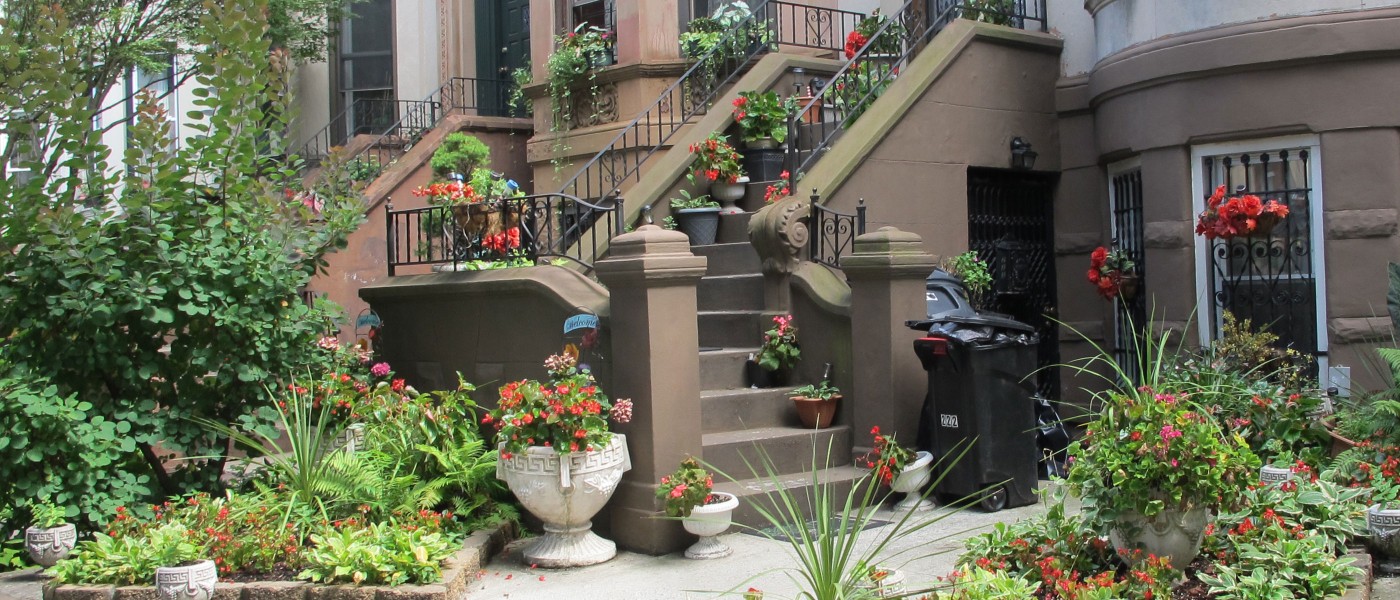Quiz: How Much Do You Know About Gardening In the City?
Gardening in Brooklyn or in any city requires some special knowledge. Lovely, healthy plants are thriving in window boxes, stoop containers, and tree beds all over the borough thanks to some very committed neighborhood gardeners. How much do you know about urban gardening?
In honor of the Greenest Block in Brooklyn Contest’s 25th season, test yourself.
1. How should you irrigate your garden bed or planter to best make use of water?
A. Water early in the morning.
B. Take your time and water deeply.
C. Water the roots, not the leaves.
D. All of the above
The correct answer is D. All of the above. All three are great ways to water your plants while making smart use of tap or rainwater.
Water in the mornings when temperatures are cooler and precious H2O isn’t lost to evaporation as quickly as in the heat of the afternoon.
Water less frequently but more thoroughly. Plants respond to slow, deep watering by growing bigger, healthier root systems, which mean bigger, healthier plants.
Watering beneath the leaves cuts down on evaporation loss and spillage. Try this cheap, simple trick: take a bucket with small holes poked in the bottom, or an inverted repurposed soda bottle with a hole poked in its cap, and sink it a few inches underground. Fill it with water for a slow but thorough drink.
Finally, try harvesting rainwater in a rain barrel or other receptacle. Doing so makes use of a free, natural resource and helps prevent combined sewer overflow. Rainwater also happens to very well-suited for plants. Its natural acidity helps balance city soils that have become alkaline from lime leached from cement. Rainwater is also higher than tap in nitrogen, a needed nutrient, and it lacks chlorine, which is toxic to plants.
See Brooklyn Botanic Garden’s Guide to Rainwater Harvest for more advice.
2. What are good fertilizers for a window box or planter?
A. Compost or worm castings
B. Diluted fish emulsion
C. Chemical fertilizer (you know, the blue stuff)
D. Plants don’t need fertilizer.
The correct answers are A. Compost or worm castings and B. Diluted fish emulsion. Container plants need to be fed as well as watered. Nutrients tend to wash right out of planters when water runs through the drainage holes, so your plants need periodic fertilizing to stay healthy.
Water your containers every few weeks with a diluted, natural liquid fertilizer like fish or kelp emulsion (be sure to follow dosage directions). Or sprinkle a layer of compost or worm castings over the soil to give your plants a nutrient boost. Compost will also strengthen soil structure and help your soil retain water.
Avoid chemical fertilizers. They contribute salts that ultimately damage soil structure and can run off and pollute waterways.
See Using Redworms for Indoor Composting for more detailed instructions on vermicomposting.
3. What is wrong with this street tree bed?
A. The soil level has been raised around the base of the tree.
B. The mulch is right up against the bark.
C. The tree guard creates a wall that prevents rainwater from rolling off the sidewalk into the tree bed.
D. All of the above
The correct answer is D. All of the above.
Sometimes well-intentioned gardeners kill their trees with kindness. This neat and tidy tree bed is one example.
Never raise the soil level in a tree bed. This rots the bark and degrades root health. If a tree bed doesn’t have enough soil to hold additional plants, help the tree by simply adding mulch to the bed. Put your plants in a container instead.
Be sure to avoid over-mulching. The mulch layer should not be more than an inch or two deep and should not reach the trunk. Leave a ring of exposed soil about eight inches wide around the tree. If the mulch touches the tree’s base, it can encourage unhealthy fungi and disease.
Tree guards are useful for protecting a tree bed from dogs, trash, and foot traffic. But they must meet certain requirements: They must allow rainwater to reach the soil and must not interfere with tree growth. And never use a tree guard to contain added soil or mulch.
See this Street Tree Bed Care tipsheet for more ideas.
4. Dog waste in a tree or garden bed…
A. is fine. Dog urine waters the plants.B. is okay because dog waste makes good fertilizer.
C. is a problem. It’s harmful to trees and other plants.
The correct answer is C. It’s harmful to trees and other plants.
Dog waste is not harmless or in any way beneficial to trees and other plants. Not only does it make the soil foul-smelling and unpleasant to garden in, it also causes problems with soil chemistry.
Dog urine doesn’t “water” plants. It does just the opposite—it starves plant roots of water. A spokesperson from the New York City Department of Parks and Recreation explained it this way:
“The extra salt can create a crust, which makes the soil almost impenetrable to water. Salt also draws water from roots, further compounding water loss and simulating the effects of drought. These problems are exacerbated because dog urine attracts more dogs to do the same. Tree beds are very limited in water, air, soil, and nutrient availability. The soil is also very compacted, which further intensifies the damage.”
Many dog owners believe that their dogs simply can’t resist a tree bed, but that’s just not true. Guide your dog away from the tree bed. Be consistent, reward, and praise lavishly. The dog will learn.


